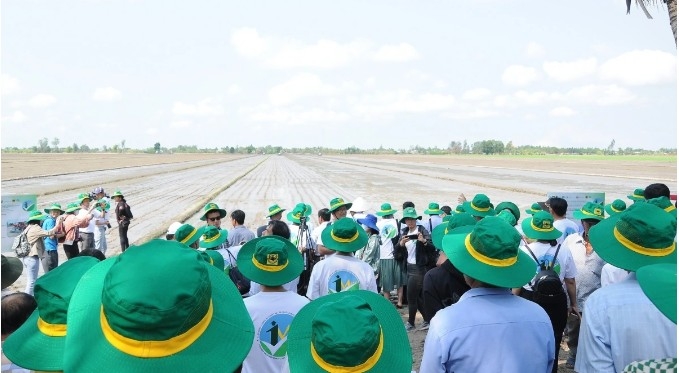Changing mindsets toward sustainable agriculture
VOV.VN - Over the years, the Mekong Delta has consistently affirmed its role as a key pillar of the Vietnamese economy, contributing 31% of the agriculture sector’s GDP with its strengths in rice, seafood and fruit cultivation.

Meanwhile, the region’s agricultural sector is undergoing transformation in the context of global integration and shifting toward green consumption trends.
As a major economic zone with favorable agricultural conditions, the Mekong Delta plays an important role in Vietnam’s farm produce exports. Half a century ago, the region’s agriculture was still underdeveloped, mostly serving domestic needs. Today, it has risen to become one of the world’s leading exporters of farm produce.
In 1975, the delta had just over 2 million hectares of rice fields, mostly single-crop paddies with low productivity, yielding only 5 to 7 million tonnes per year. Though the country had unified, the heavy toll of war meant Vietnam had to import over 2 million tonnes of food annually.
Fifty years later, rice output in the Mekong Delta has risen to over 20 million tonnes a year. Vietnamese rice production and exports are now part of a global value chain.
This April, the 50-hectare rice fields of Tien Thuan Cooperative in Thạnh An Commune, Vinh Thanh District stand as a model in Can Tho province’s implementation of the one-million-hectare high-quality, low-emission rice project for the region.

Nguyen Cao Khai, the cooperative’s director, said following the project’s cultivation procedures helped reduce seed, fertilizer and pesticide use while increasing yields and product quality. As a result, farmers are earning more compared to traditional farming methods.
“Compared to conventional farming, the circular model brings in an extra VND 2 to VND6 million per hectare. I’ve cut costs, reduced pesticide use by two to three rounds, and the crops are more stable overall,” Khai shared.
Beyond rice, a shift in mindset toward sustainable agriculture has allowed local specialties like longan and mango from Co Do District, Can Tho City to access high-end markets including the US, Australia, Japan, Thailand, the EU, China and the Republic of Korea (RoK).
Tran Phuoc Son, from Trang Ti Garden Fruit Cooperative in Co Do District, said they focus on quality and branding to boost competitiveness.

“We focus on quality because if it’s good, businesses will come to us. That’s why we’re building a brand and ensuring high standards. To compete, we must innovate and go clean to guarantee safety and flavor,” Son said.
According to the 2023 Mekong Delta Annual Economic Report by the Vietnam Chamber of Commerce and Industry and Fulbright School of Public Policy and Management, agriculture remains the most important contributor to the region’s GRDP. It is also key to ensuring national security, political stability and economic growth.
The region’s four economic cornerstones – rice, shrimp, pangasius and fruit – not only bring better livelihoods for locals but also help expand exports and raise the global profile of Vietnamese produce.
With its strengths in aquaculture, fruit and rice, the Mekong Delta has steadily expanded investment and trade with countries across the region and the world. Many of its farm products have established strong brands in export markets.
Tran Thai Nghiem, deputy director of Can Tho’s Department of Agriculture and Rural Development, said the city produces about 1.3 million tonnes of rice and 200,000 tonnes of fruit annually. Authorities have supported farmers in adopting production standards, building area codes and boosting links between cooperatives and businesses to enhance value and meet market demands.
“We’re working to connect with businesses to ensure stable output, while also promoting supporting sectors like preservation and processing – key to sustainable fruit development. Localities are also advancing agricultural production and multi-value integrated farming under the One Commune One Product program (OCOP) program,” Nghiem added.
On November 27, 2023, the Prime Minister approved a project for the sustainable development of one million hectares of high-quality, low-emission rice cultivation tied to green growth in the Mekong Delta. The initiative aims to shift toward sustainable rice farming, boost the value of Vietnam’s rice sector, improve farmer incomes, and cut greenhouse gas emissions, aligning with the country’s international commitments.
Le Thanh Tung, Vice Chairman of the Vietnam Rice Industry Association, said the project has delivered practical benefits by reducing seed rates, fertilizer and pesticide use while raising yields and cutting emissions. The plan also highlights the importance of linking farmers with businesses, which is key to the project’s success.

“The project helps reduce 5 to 6 tonnes of carbon per hectare per crop, while raising profits by over VND5 million per hectare. This proves that the technical, technological and commercial targets are achievable. The connection between cooperatives and businesses is fully viable, and we have grounds to scale this up to one million hectares,” Tung said.
The one-million-hectare rice project brings fresh momentum to the region’s agriculture. Pham Thai Binh, director of Trung An High-Tech Agriculture JSC, noted that farmers and cooperatives have embraced the initiative, while businesses are optimistic as the value chain takes shape.
“Meeting the project’s criteria isn’t difficult and local authorities, farmers and businesses have already done it. This time we’re going further, doing it more thoroughly and at a higher level to elevate Vietnamese and Mekong Delta rice to new heights. “It’s about adapting to climate trends and deepening the farmer–business connection to keep adding value,” Binh emphasized.
Over the years, the Mekong Delta has reaffirmed its importance as the backbone of Vietnam’s agriculture, contributing 31% of the sector’s GDP with rice, seafood and fruit as its hallmarks. Now, the region is undergoing a strong transformation, adapting to global integration and climate change, while embracing green consumption trends.



